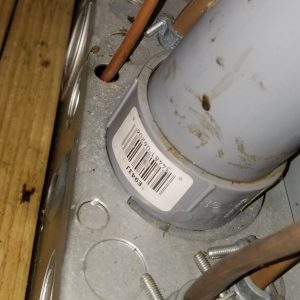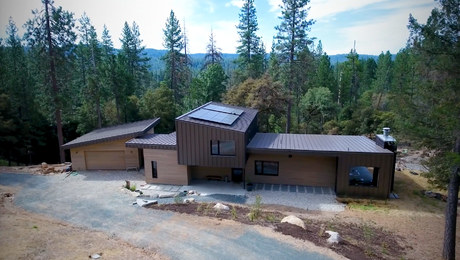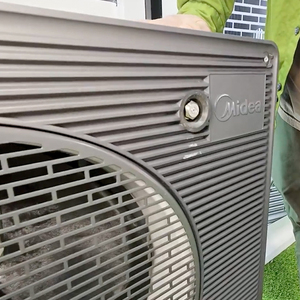My log home had the meter near an outside corner, then the main service wires came through the sill log and down into my breaker box, which was mounted to the basement wall. Over time, the seals around the meter and incoming lines failed, and water made it’s way into the box. The electrician came out, put in new meter, service wiring, and breaker box. This time however, he used wood blocking to offset the box from the basement wall. *see pictures*
But today I went down to flip a breaker and noticed water drops on the main service conduit. From the pictures you can see there’s a gap in the line, is that supposed to be there? Also, I see a smaller hole to the left where he apparently began to drill the new hole and changed his mind because there’s a lot of moisture around that spot. It’s cold at the sill log, and I can use pipe insulation, but what kind specifically? Should I use duct seal at the inlet? Or duct seal and then some type of fireproof insulation board? The moisture is running down the conduit and I’m very worried. So far the professionals have been the ones fixing one issue and creating a new one. You can see why I’m reluctant to call them back for a third go.
Discussion Forum
Discussion Forum
Up Next
Video Shorts
Featured Story

Learn how the pros keep their hand tools sharp without breaking the bank.
Highlights
"I have learned so much thanks to the searchable articles on the FHB website. I can confidently say that I expect to be a life-long subscriber." - M.K.
Fine Homebuilding Magazine
- Home Group
- Antique Trader
- Arts & Crafts Homes
- Bank Note Reporter
- Cabin Life
- Cuisine at Home
- Fine Gardening
- Fine Woodworking
- Green Building Advisor
- Garden Gate
- Horticulture
- Keep Craft Alive
- Log Home Living
- Military Trader/Vehicles
- Numismatic News
- Numismaster
- Old Cars Weekly
- Old House Journal
- Period Homes
- Popular Woodworking
- Script
- ShopNotes
- Sports Collectors Digest
- Threads
- Timber Home Living
- Traditional Building
- Woodsmith
- World Coin News
- Writer's Digest





















Replies
You need to seal the outside. Likely water is getting inside the conduit.
It's been sealed with a foam, do you recommend I scrape it off, what I can, and reseal with something better? I've heard the foam breaks down over time. Will the duct seal work outside?
That could be condensation on the bottom of the conduit. Cold air sinking down chills the conduit, and humidity condenses. Or it could be an active leak. You should figure out which. That joint needs to be glued together though, and the electrician should have made sure it was. Usually, electricians do use duct seal outside.
He definitely used some sort of spray foam outside. As for the gap in the joint, it's right where the elbow fits into the bell, what do you suggest I use to join the gap? It would have to be a split coupling or something like that.
Pretty hard thing to do now. Was the joint tight before they redid the service? Or did they run new conduit? In both those cases, Sparky should have made the joint tight.
On the outside, I believe you're looking to use what's called "duct seal," such as that made by Gardner-Bender (google it and you'll see lowes and home depot sell that brand). It's like modeling clay. Every outdoor box/intrusion I've ever had installed, my electrician has used that. I don't think spray foam will do the work (and especially keep out rodents, who will chew right through foam). I also think your electrician needs to do a better job of cutting and installing conduit. That shouldn't be separated.
@Andy_Engel it's all new conduit, meter head, panels, new everything. The water intrusion last time shorted the old box out and it melted the wires etc.
@Mikeljon yes, the duct seal I'm familiar with. I was wondering if I should use it on the inside too? Against that sill log. But smooth it out so it's as flush as possible, and then maybe add a small piece of insulation board there.
well, the outside is where it prevents water intrusion. On the inside, it would seem possible to trap bulk water that is making its way in. I'd focus on stopping it from the outside. Then, once that's solves, spray foam the inside for insulation and air leakage. (And listen to Andy Engel--he's the expert!)
Thanks, I'll give the duct seal outside a go. I'm still unsure what to do about the gap in the conduit.
Make your electrician come back out and fix it.
I had an annoying experience recently. Put in a whole house generator. I mounted the transfer switch in a place where later I'm putting cedar shingle siding. So I mounted it on a nice cedar frame. Put the box up with lags into the studs, predrilling first so the cedar didn't split. Had it perfectly set. I also had all the conduit in the ground (followed electrician's directions for depth, had it inspected for close-in). I also put the pull rope in the conduit. Electrician shows up on a day I needed to leave. I pointed out how I had the box all preset and wanted it to end up back in the alignment with woodworking precision. He nodded, said sure. I came back and he was already gone but the damn thing was an inch up and over, and he put the large lags back into the cedar without predrilling and split two of them out. I made him reset the whole thing (that is, took it off and I moved the backer).
That's the type of thing that happens to me all the time. My name is probably flagged for complaining, but it's MY home and I'm paying for repairs to be made. I have no problem having to budge on preference if it's a code issue, but when it's just oversight or lazy work it's so maddening. If you're paid to do the job, do it. If I knew how to fix it with no doubts, I would, but that main service wire makes me a little nervous. I think you're spot on having him come back to fix it. I hate to, but I don't want to pay twice for the same thing.
Exactly. This is on the electrician to fix.
I'd put a flashing cap over the whole thing. That would prevent any rain or snow from getting in and reduce your dependence on caulks and sealants. You still want to caulk with a good polyurethane to keep air and condensation out.
“[Deleted]”
That Flashing cap is a good idea, thanks. It never even crossed my mind, I was so focused on that gap. However, one of the guys from the electric co. was out working near the house so I had him stop by just as a courtesy, he looked at the situation real quick and mentioned putting insulation inside the conduit elbow outside below the meter to prevent the cool air from condensing inside the house. Then he laughed at me when I said how worried I was about the gap, saying this conduit can be buried underground - a little basement air isn't going to hurt. But I'm still facing the water and breaker box issue until the electrician comes out.
The original electrician is no longer around, I'm not sure if that meant fired or he had passed away. Nevertheless, had another guy out, and he inspected the work done and fixed what we needed. Luckily, it was only condensation and not actual rain water. There was no water damage inside the main breaker box, nor had it made it's way past the last coupling.
He also duct sealed the main line at the breaker box inlet - at the top, put insulation in the conduit, via the LB, to stop the cold air flow and condensation on the basement side of the conduit, resealed all entries into the house, and shifted the box inside to close the gap. It's been 4 days and it's been freezing cold weather. No condensation, no problem. In fact, the rim joists have started to dry significantly where the line comes in. They had been very damp prior. Thanks for all the help and info!